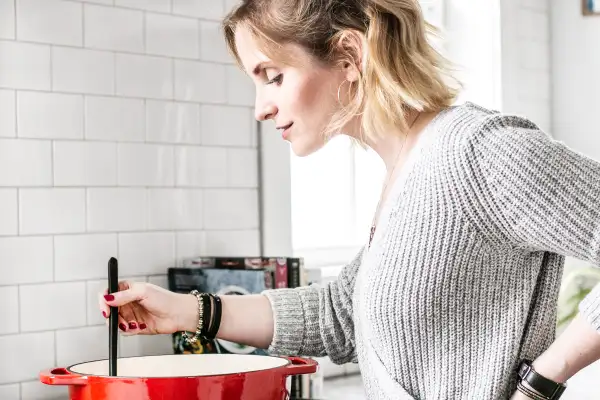3 Mistakes That Are Costing You Tons of Money at the Grocery Store, According to a Budget Food Blogger

Beth Moncel counts every penny she spends on her meals.
The chef behind the food blog Budget Bytes has created hundreds of recipes, going above and beyond to calculate the cost to produce each meal — down to the last cent. Broccoli cheddar tots? Those cost $3.22. Her taco bowls come in at $1.72 (made with exactly 3 cents worth of salt and pepper). And her cranberry orange cream scones are only 11 cents each.
The Nashville-based budgeter is such a pro, she can rattle off the price of any ingredient and uses her expertise to craft low-cost meals. “You get to see the relationship between the cost of ingredients to know when you should use more of one and less of another," she says.
Moncel began pinching pennies in her twenties, while working full-time at a low-paying job and staring down $90,000 of student loan debt. Already a careful spender, her grocery budget was the only area in which she could further cut back.
Using her degree in nutritional science, Moncel combined her ability to break down food components with her love of personal finance to figure out just how much she was spending on every meal. She quickly realized how much money she could save by swapping out expensive meats for a can of beans or ditching pre-chopped veggies.
She starting her blog a decade ago, Moncel has written a cookbook, launched her own app, and helped thousands of people cut down their budgets.
The blogger shared the biggest mistakes people make when trying to save on groceries — and fast ways you can cut back on your spending now.
Don’t buy anything you can make yourself — including bread.
There’s no debate here: Eating out regularly will kill your budget. That $10 you spend at Chipotle could buy you enough beans and tomatoes to make chili for six dinners, Moncel says. While many working people can’t feasibly cook every meal, the food blogger stresses cooking even just one large batch of food is worthwhile.
“You don’t have to make these big elaborate recipes," she says. "You can make something as simple as a skillet pasta dish with two or three ingredients and you’ll have leftovers for a few days."
In addition to meal prepping, making smart choices about ingredients can also help your budget. Raw ingredients like rice, pasta, and dry beans are usually the least expensive part of a meal, and sturdy veggies like cabbage and sweet potatoes can ring up for as little as a dollar per pound. Compare that to prepared items — like precut fruits and veggies, stuffed chicken breast, and frozen skillet meals — which are priced high as a trade-off for their convenience.
Baking your own bread is one way to save: A $4 loaf of bread can cost less than 50 cents if you bake it yourself. Moncel’s no-knead bread recipe uses only 29 cents worth of flour, and the only effort required is mixing the ingredients and placing the bread in the oven for an hour. (Plus, that fresh-baked bread smell is priceless.)
Clipping coupons may not save you money.
Though many frugal shoppers tout the money-saving benefits of coupon clipping, Moncel says deals are often not as good as they seem.
Stores typically offer coupons for pre-packaged meals and snacks, which are products shoppers should not be wasting money on anyway, says Moncel. Instead, she looks for deals on meat and produce using the Flipp app, and advocates buying cheap produce in bulk.
The blogger also recommends visiting two grocery stores in order to spot price discrepancies. "If I have the time, I’ll also go to farmers' markets and international grocery stores because they have certain ingredients that are way less expensive compared to regular grocery stores," she says.
You don’t need fancy gadgets to meal prep.
Fancy kitchen appliances like the Instant Pot or Ninja Blender may be trendy, but Moncel stresses that you don’t need to spend hundreds of dollars to make good food quickly.
“I am all about keeping it really simple when it comes to kitchen equipment,” she says. “People have been making food for a thousand years without fancy gadgets.”
Instead, Moncel suggests that cooks invest in a quality chef's knife, and basic tools that can be used in multiple ways. Rather than investing in a blender, Moncel bought a food processor because it can better blend thicker ingredients like hummus. A food processor can also cut butter into flour for pie crusts and mix dry ingredients in ways a blender can’t. A cheese grater can also do more than cut dairy. Moncel uses hers to grate ginger or slice veggies for stir fries.
With Moncel pushing conventional grocery wisdom out the door, now it's time to take a bite out of your own budget.